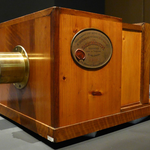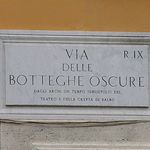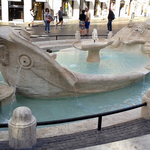Bocca della Verità
The stone disco represents the face of a river divinity.
In the time of the ancient Romans it served as a drain cover which was set in the centre of the temple under open sky dedicated to Hercules Winner and had to carry the rainwaters into the cloacae. It was found in the Middle Ages and moved up on the capital of the porch in Santa Maria in Cosmedin. The cover has become more than a document but a symbol. Yesterday it was an object of superstition, today it is an object of curiosity. According to the legend it was created by Virgilio Magro (magro means slim). They believed that he had the magic power to cut the fingers of those who did not say the truth after with his hand slipping into the mouth.
Today it mostly attracts the attention by the idea that in some way the ancient mask can renew its magic.
The church of Santa Maria in Cosmedin was built in the VIth century above a big arcade hall dating to the flavian age. From that age several columns joint to the edifice are remained.
That edifice rose up close to a magnificent altar and two temples dedicated to Hercules Unconquered and Ceres. Enlarged by Hadrian I in the VIIIth century it was given to Greeks which persecuted by orient iconoclastics escaped. They settled up in the quarters along the Tevere.
The Greeks called her "Greek School" but they decorated it so well that it was worth calling it the Kosmidion (it meansornamento). Cosmedin derives from that word.
As the church was dedicated to Maria it acquired the name of Santa Maria in Cosmedin. The bell tower with seven orders of mullioned windows is among the most beautiful one of Romanesque style.
The church is located on the Piazza della Bocca della Verità which from the first sight it is possible to see three epochs and three different styles united together as if they were on the same theatre stage.
The Temple of Vesta and Fortuna Virile belongs to the ancient Rome otherwise the church of Santa Maria in Cosmedin belongs to the Middle Ages and the fountain to Clement XI refers to the baroque style
Initially the square merchants, moneychanger and sailors came to the square. There are forums of Boario and Olitorio where the animals, oil and vegetables were traded while in the river harbour which was in front of the square the ships arriving from the East docked.
Livius said that once in the winter day of 218 a.c. an ox ran away from Forum Boario then rose to the third floor of a nearby building and threw itself down. The event was the sign of an upcoming disaster. It was the arrival of Hannibal.
With the fall of the Roman Empire the square is a favourite place of Greeks: their colony enriched all the area by the Byzantium influence and the Church of Santa Maria in Cosmedin is an example of it.
The fountain was created by Carlo Bizzoccheri in 1715 by the order of Pope Clement XI. It has a large mixtilinear basin. The basin contains the fanciful rock on which two travertine tritons with crossed rise. The tritons hold two joint shells. This fountain was inspired by the Bernini fountain on the Barberini square. The fountain is the baroque masterstroke surrounded by the severe atmosphere and in the past it was abandoned and empty.
People got back to the square towards the end of '700 when Mastro Titta operated here. He was the most famous executioner of the town. Besides one could meet here Gian Battista Bugatti who was a fat and quiet man of the people known as a great specialist in cutting human heads: he cut 516 heads in 70 years.
His work was regarded to be some sort of a show and Romans brought either their children to see it.
In the opposite, in the green area a temple stands which is by mistake called the Temple of Fortuna Virilis. It was probably dedicated to "Portunus" who was the god of the greek river port.
It appears to be a rare example of greek and latin architecture put up in the second half of the II century and reconstructed in the first part in the I century. It has a majestic look in spite of the modest proportions.
Right near one can see a temple of Vesta. It was called so because its form reminds the one of Vesta in the Roman Forum really dedicated to the Hercules the Winner.
It was raised at the end of the IInd century a.c. and restored in the time of Tiberius as it showed the enrolment of recent discoveries.

 The records of Rome. Big numbers, not always enviable, for a big city.
The records of Rome. Big numbers, not always enviable, for a big city. New Phot-O-Matic section. To spend some time looking at photos (also) of Rome.
New Phot-O-Matic section. To spend some time looking at photos (also) of Rome. The administrative, urban, toponymic and imaginative subdivisions of Rome.
The administrative, urban, toponymic and imaginative subdivisions of Rome. Notice for tourists: in Rome you drink for free. Historical fountains and 'big noses'.
Notice for tourists: in Rome you drink for free. Historical fountains and 'big noses'. Free museums return on the first Sunday of the month.
Free museums return on the first Sunday of the month.